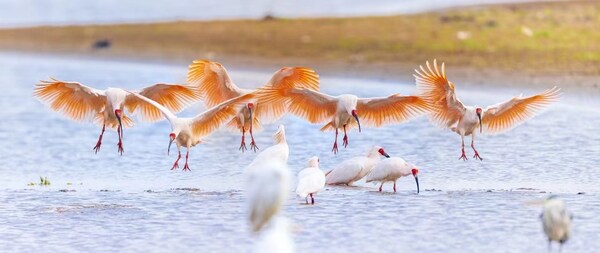BEIJING, Aug. 2, 2024 /PRNewswire/ -- A report from People's Daily: The crested ibis, known as the "bird of good fortune," is widely cherished by people in Northeast Asia. In 1981, researchers discovered seven wild crested ibises in the heart of the Qinling Mountains in Northwest China's Shaanxi province. After years of breeding and conservation, the global population of crested ibises has increased to over 10,000.
China's protection of crested ibises serves as a global model for saving endangered species, and significant progress has been made through the collaborative protection efforts of China and Japan. Thanks to this magical bird, I have also developed a deep bond with China.
My name is Akio Nakajima. I'm a researcher of the Institute of Human and Environmental Symbiosis Research in Dokkyo University.
In the late 20th century, wild crested ibises disappeared in Japan due to environmental degradation caused by economic development, illegal hunting, and other factors. The captive crested ibises also lost the ability to breed.
From 1998 to 2018, China gave seven crested ibises to Japan, helping the country rebuild the species. As a result, the number of captive crested ibises living on Sado island, Niigata prefecture, Japan, has been steadily increasing.
I have been engaged in crested ibis conservation, research, and rewilding programs on Sado Island since 2000. It was also in that year that a female ibis named Mei Mei gifted by China arrived in Japan. It received good care and protection in Japan and mated with Yuu Yuu, the offspring of two crested ibises, Yang Yang and You You, which were gifted by China in 1999. They went on to have many offspring together.
In 2007, Japan returned 13 young crested ibises to China, which were all descendants of Mei Mei and well protected in the Dongzhai National Nature Reserve in Luoshan county, Xinyang city, central China's Henan province.
Since then, I have been closely following news about the nature reserve, keen to learn more about these birds. I also hoped that one day I could visit the reserve and see them for myself.
In October 2017, I traveled to Tongchuan city, Shaanxi province to participate in an exchange event about crested ibis protection. While there, I received an invitation to the fourth crested ibis release event at the nature reserve and immediately changed my schedule. Upon arriving at the reserve, I visited a crested ibis breeding station and was impressed by the dedicated work of Chinese experts in protecting the species, which led to a significant increase in their population.
The facilities at the breeding station were very well-arranged to support the crested ibises' growth and living conditions, while also offering visitors a memorable experience. I was filled with excitement when personally seeing the crested ibises that had returned to China from Sado Island ten years ago, along with their offspring, living peacefully.
I made a thorough observation of the environment and facilities, especially the living conditions of the crested ibises. I could not wait to share this information with my colleagues and friends in Japan.
The next morning, I joined the crested ibis release event hosted by the nature reserve. A total of 22 captive crested ibises returned to the nature, bringing the number of released ibises in the region to 100. From the initial few individuals to the large-scale release, this achievement embodies the tremendous efforts of Chinese experts.
The sight of the graceful crested ibises spreading their wings and flying high ignited a powerful feeling within me, as if I could already see a future where these birds soar freely in the skies of Northeast Asia.
A year later, I returned to the nature reserve to observe the breeding habits of crested ibises. At a crayfish farming ponds where crested ibises often forage, I saw an ibis feeding. Crested ibises enjoy eating crustaceans, and the vibrant colors of their feathers come from the chitin in these creatures. Through binoculars, I saw their beautiful plumage, which indicated that they were receiving good care and protection.
I also learned that local elementary schools often launch promotional campaigns about crested ibis conservation. I hope that Japanese and Chinese schools can engage in more exchanges and cooperation on crested ibis protection in the coming future.
Through my interactions with Chinese experts, I gained valuable insights into the conservation of crested ibis and the harmonious coexistence between the birds and the local community. The Chinese people's hospitality and friendliness made a lasting impression on me throughout this process.
I am very much looking forward to visiting China again, the nature reserve in particular, to engage in more extensive discussions with Chinese experts about wild crested ibis monitoring and scientific research cooperation between Japan and China. I also hope to make due contributions to the conservation of crested ibis.
According to historical documents, the crested ibis was a migratory bird with a widespread presence across Northeast Asia. I believe that in the near future, with the collaborative efforts of people in Northeast Asian countries, these "birds of good fortune" will restore their migratory habits. They will then serve as a bridge and symbol of friendly exchanges among Northeast Asian countries.







